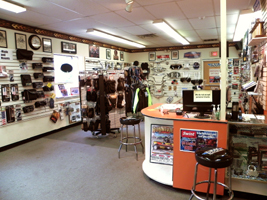See Our Motorcycle Shop for Expert Recommendations and High Quality Products
See Our Motorcycle Shop for Expert Recommendations and High Quality Products
Blog Article
Recognizing the Crucial Components of a Motorcycle: A Comprehensive Guide for Enthusiasts
For motorbike fanatics looking to raise their riding experience and guarantee their bikes run smoothly, recognizing the necessary elements of a motorcycle is paramount. Each element, from the engine's detailed workings to the critical function of the stopping mechanisms, not just impacts efficiency however also safety and comfort. This overview will certainly go through the essential parts that every rider must be acquainted with, making it possible for educated options in both upkeep and possible upgrades. As we start this exploration, one must ask: just how does each part engage to create the seamless ride every enthusiast seeks?
Engine Elements

The camshaft plays a critical function in controlling the timing of the engine's shutoffs, guaranteeing the precise opening and closing needed for efficient fuel and air intake, along with exhaust expulsion. This timing is vital to maintaining optimum engine efficiency and effectiveness. In addition, the carburetor or fuel shot system, depending on the motorbike version, is accountable for blending air with gas in the right ratio for combustion.
The air conditioning system, either air or liquid-based, functions to maintain the engine's temperature within functional limitations, stopping overheating and guaranteeing longevity - motox parts nz. Each component, carefully developed and integrated, adds to the seamless procedure of the engine, specifying the motorcycle's power output and general efficiency
Transmission System
Indispensable to the motorcycle's functionality, the transmission system makes sure reliable power transfer from the engine to the wheels. This system consists of numerous crucial elements, including the clutch, gearbox, and final drive, each playing a crucial duty in translating the engine's power into motion. The clutch, commonly run by a hand lever, serves to engage and disengage the engine from the transmission, allowing for smooth gear changes and controlled acceleration.
The gearbox, often referred to as the transmission proper, has a collection of equipments that cyclists can by hand move with to adjust the bike's rate and torque outcome. These gears are organized in a sequence that enables the motorcycle to increase efficiently and preserve optimal engine efficiency throughout different speeds. Most bikes make use of a consecutive gearbox, requiring the motorcyclist to change equipments in a fixed order.
Braking Devices
While recognizing the transmission system is key to utilizing a motorcycle's power, just as crucial is the capability to manage and stop that power efficiently, which is where stopping systems enter into play. Brakes are important for safety and efficiency, supplying the biker with the required control to browse different terrains and problems. Usually, motorcycles include two kinds of stopping systems: disc brakes and drum brakes.
Disc brakes are a lot more common in modern motorbikes due to their superior performance. They are composed of a brake disc, caliper, and pads. When activated, the caliper presses the brake pads visit this page against the spinning disc, transforming kinetic energy into warmth, thus reducing the wheel. This system provides far better heat dissipation, constant efficiency, and enhanced stopping power, specifically in wet problems.
Conversely, drum brakes, though less usual, are still discovered in some bikes. They work by pressing brake shoes useful link against the internal surface area of a drum affixed to the wheel. While typically much less reliable in warmth dissipation and stopping power, drum brakes are simpler and a lot more affordable.
Comprehending these stopping systems' nuances enables cyclists to preserve their motorbikes correctly and value the design that guarantees secure and effective stopping.
Suspension and Guiding
Suspension and guiding systems are essential components that substantially affect a bike's handling and adventure comfort. The suspension system, being composed of forks at the front and shock absorbers at the back, soaks up road irregularities, enhancing stability and control. Front forks, inverted or normally telescopic, compress and rebound to alleviate effects, while back shock absorbers preserve tire contact with the road, important for grip and safety and security.
Steering, centered around the handlebars, connects the biker to the bike's directional control. The guiding head bearings make certain smooth procedure, enabling accurate ability to move. Appropriate alignment and maintenance of these bearings are essential for foreseeable steering reaction and lowering rider exhaustion.
The suspension's adjustability is another crucial element; preload, damping, and rebound settings permit modification to fit various riding conditions and designs. This versatility is important for optimizing efficiency, whether navigating city roads or dealing with tough trails. Technologies like digital shock absorber provide real-time modifications, improving experience high quality across diverse terrains.

Electrical Equipments
After making sure a controlled and smooth ride via effective suspension and steering systems, attention turns to the electric systems, a crucial facet of modern motorbikes. These systems play an important role not only in beginning the engine yet also in powering numerous parts that enhance the capability and safety and security of the motorbike.
At the heart of a motorbike's electric system is the battery, which shops electrical energy needed for beginning the engine and powering supporting systems - mx gear nz. The alternator or generator, combined with the rectifier-regulator, guarantees the battery stays charged while the motorcycle functions, converting mechanical power right into electric power and maintaining voltage levels
The ignition system, another important part, is in charge of igniting the air-fuel mix in the engine's cylinders. Modern motorbikes commonly make use of a digital ignition system, offering greater efficiency and reliability compared to conventional systems.
Illumination this hyperlink systems, including headlights, tail lights, and indicators, are also important, making sure exposure and security for the motorcyclist. Extra electronic components such as sensors, control units, and displays add to innovative features like gas injection administration, anti-lock stopping systems (ABDOMINAL MUSCLE), and digital dashboards, further enhancing the riding experience.
Verdict
A complete comprehension of a bike's crucial components, consisting of the engine, transmission system, braking mechanisms, suspension, guiding, and electrical systems, is crucial for lovers intending to maximize convenience, safety and security, and performance. Proficiency of these elements enables for educated decisions pertaining to maintenance and upgrades, inevitably boosting the riding experience. By integrating this understanding, cyclists can ensure their motorbikes operate at peak effectiveness and integrity, thereby optimizing both pleasure and long life of their vehicles.
For motorbike fanatics looking to raise their riding experience and guarantee their bikes run smoothly, understanding the essential elements of a motorbike is paramount.Important to the bike's performance, the transmission system makes sure efficient power transfer from the engine to the wheels.While comprehending the transmission system is vital to utilizing a motorbike's power, similarly vital is the ability to manage and stop that power successfully, which is where stopping mechanisms come into play. Usually, motorbikes feature 2 types of braking systems: disc brakes and drum brakes.
A detailed comprehension of a motorcycle's important elements, including the engine, transmission system, braking systems, suspension, steering, and electric systems, is vital for fanatics intending to enhance comfort, safety, and efficiency.
Report this page